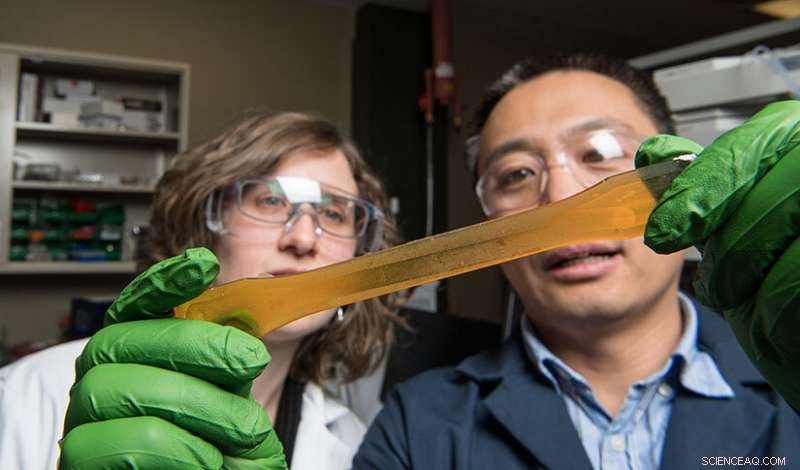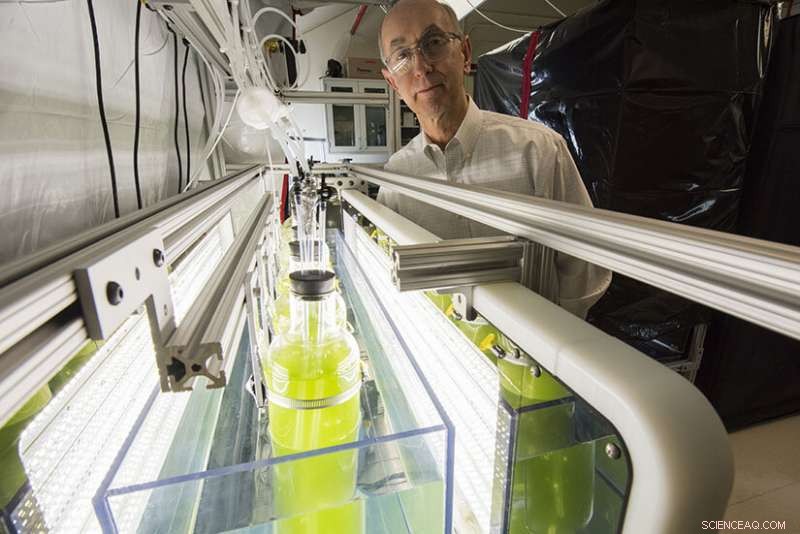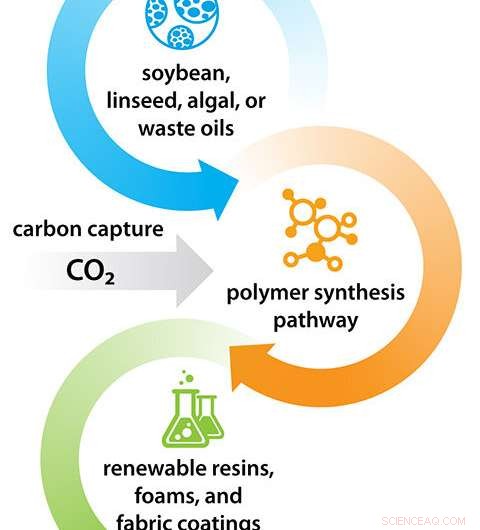
Une formule renouvelable révolutionnaire - Tao Dong (à droite) chercheur au NREL et l'ancienne stagiaire Stephanie Federle (à gauche) examinent les produits biosourcés, résine polyuréthane non toxique, une alternative prometteuse au polyuréthane conventionnel. Crédit :Dennis Schroeder, NREL
Sans ça, le monde pourrait être un peu moins doux et un peu moins chaud. Nos vêtements de loisirs pourraient perdre moins d'eau. Les semelles intérieures de nos baskets peuvent ne pas offrir le même soutien thérapeutique de la voûte plantaire. Le grain du bois dans les meubles finis pourrait ne pas « pop ».
En effet, le polyuréthane, un plastique courant dans des applications allant des mousses pulvérisables aux adhésifs en passant par les fibres de vêtements synthétiques, est devenu un incontournable du 21e siècle, ajouter de la commodité, confort, et même la beauté à de nombreux aspects de la vie quotidienne.
La grande polyvalence du matériau, qui est actuellement fabriqué en grande partie à partir de sous-produits du pétrole, a fait du polyuréthane le plastique de prédilection pour une gamme de produits. Aujourd'hui, plus de 16 millions de tonnes de polyuréthane sont produites dans le monde chaque année.
"Très peu d'aspects de nos vies ne sont pas touchés par le polyuréthane, " a réfléchi Phil Pienkos, un chimiste qui a récemment pris sa retraite du Laboratoire national des énergies renouvelables (NREL) après près de 40 ans de recherche.
Mais Pienkos, qui a construit une carrière dans la recherche de nouvelles façons de produire des carburants et des matériaux biosourcés, a déclaré qu'il y avait une poussée croissante pour repenser la façon dont le polyuréthane est produit.
« Les méthodes actuelles reposent en grande partie sur des produits chimiques toxiques et du pétrole non renouvelable, ", a-t-il déclaré. "Nous voulions développer un nouveau plastique avec toutes les propriétés utiles du poly conventionnel, mais sans les effets secondaires coûteux sur l'environnement."
Était-ce possible ? Les résultats du laboratoire donnent un oui retentissant.
Grâce à une nouvelle chimie utilisant des ressources non toxiques comme l'huile de lin, graisse usagée, ou encore des algues, Pienkos et son collègue du NREL Tao Dong, un expert en génie chimique, ont développé une méthode révolutionnaire pour produire du polyuréthane renouvelable sans précurseurs toxiques.
Il s'agit d'une percée avec le potentiel d'écologiser le marché pour des produits allant des chaussures, aux automobiles, aux matelas, et au-delà.
Mais pour saisir le poids de l'accomplissement, il est utile de revenir sur l'origine de l'avancée scientifique, une histoire qui s'éloigne des fondamentaux chimiques du polyuréthane conventionnel, dans le laboratoire d'algues où une idée pour une nouvelle chimie a émergé, et se fraye un chemin vers de nouveaux partenariats d'entreprise qui préparent le terrain pour un avenir prometteur de la commercialisation.
Une question de chimie
Lorsque le polyuréthane est devenu disponible dans le commerce dans les années 1950, il a rapidement gagné en popularité pour une utilisation dans de nombreux produits et applications. Cela était en grande partie dû aux propriétés dynamiques et ajustables du matériau, ainsi que la disponibilité et l'abordabilité des composants à base de pétrole utilisés pour le fabriquer.
Grâce à un processus chimique intelligent utilisant des polyols et des isocyanates - les éléments de base des polyuréthanes conventionnels - les fabricants ont pu adapter leurs formulations pour produire une étonnante variété de matériaux de polyuréthane, chacun avec des propriétés uniques et utiles.
Issu d'un polyol à longue chaîne, par exemple, pourrait produire des mousses flexibles pour un matelas moelleux. Une autre formulation pourrait donner un liquide riche qui, lorsqu'il est étalé sur des meubles, à la fois protège et révèle la beauté inhérente du grain du bois. Un troisième lot peut contenir du dioxyde de carbone (CO
"C'est la beauté de l'isocyanate, " a déclaré Dong en réfléchissant au polyuréthane conventionnel, "sa capacité à former des mousses."
Mais Dong a déclaré que les isocyanates entraînent des inconvénients importants, trop. Bien que ces produits chimiques aient des taux de réactivité rapides, les rendant hautement adaptables à de nombreuses applications industrielles, ils sont aussi très toxiques, et ils sont produits à partir d'une matière première encore plus toxique, phosgène. Lorsqu'il est inhalé, les isocyanates peuvent entraîner une série d'effets néfastes sur la santé, comme la peau, œil, et irritation de la gorge, asthme, et d'autres problèmes pulmonaires graves.
« Si des produits contenant des polyuréthanes conventionnels sont brûlés, ces isocyanates sont volatilisés et rejetés dans l'atmosphère, " ajoute Pienkos. Même en pulvérisant simplement du polyuréthane pour l'utiliser comme isolant, Pienkos a dit, peut aérosoliser l'isocyanate, obligeant les travailleurs à prendre des précautions rigoureuses pour protéger leur santé.

Récemment retraité, Phil Pienkos (photo) a fondé une nouvelle entreprise, Énergies renouvelables Polaris, pour aider à accélérer la commercialisation du nouveau polyuréthane, une idée qui est née à l'origine de sa recherche sur les biocarburants à base d'algues au NREL. Crédit :Dennis Schroeder, NREL
To try and tackle these and other issues—such as reliance on petrochemicals—scientists from labs around the world have begun looking for new ways to synthesize polyurethane using bio-based resources. But these efforts have largely had mixed results. Some lacked the performance needed for industry applications. Others were not completely renewable.
The challenge to improve polyurethane, alors, remained ripe for innovation.
"We can do better than this, " thought Pienkos five years ago when he first encountered the predicament. Energized by the opportunity, he joined with Dong and Lieve Laurens, also of NREL, on a search for a better polyurethane chemistry.
Rethinking the Building Blocks of Polyurethane
The idea grew from a seemingly unrelated laboratory problem:lowering the cost of algae biofuels. As with many conventional petrochemical refining processes, biofuel refiners look for ways to use the coproducts of their processes as a source of revenue.
The question becomes much the same for algae biorefining. Can the waste lipids and amino acids from the process become ingredients for a prized recipe for polyurethane that is both renewable and nontoxic?
For Dong, answering the question at the basic chemical level was the easy part—of course they could. Scientists in the 1950s had shown it was possible to synthesize polyurethane from non-isocyanate pathways.
The real challenge, Dong said, was figuring out how to speed up that reaction to compete with conventional processes. He needed to produce polymers that performed at least as well as conventional materials, a major technical barrier to commercializing bio-based polyurethanes.
"The reactivity of the non-isocyanate, bio-based processes described in the literature is slower, " Dong explained. "So we needed to make sure we had reactivity comparable to conventional chemistry."
NREL's process overcomes the barrier by developing bio-based formulas through a clever chemical process. It begins with an epoxidation process, which prepares the base oil—anything from canola oil or linseed oil to algae or food waste—for further chemical reactions. By reacting these epoxidized fatty acids with CO
By replacing petroleum-based polyols with select natural oils, and toxic isocyanates with bio-based amino acids, Dong had managed to synthesize polymers with properties comparable to conventional polyurethane. En d'autres termes, he had developed a viable renewable, nontoxic alternative to conventional polyurethane.
And the chemistry had an added environmental benefit, trop.
"As much of 30% by weight of the final polymer is CO
CO
"That means less raw material per pound of polymer, lower cost, and a lower overall carbon footprint, " Pienkos continued. "It looks to us that this offers remarkable sustainability opportunities."
A Sought-After Renewable Solution Finds Its Commercial Feet
The next step was to see if the process could be commercialized, scaled up to meet the demands of the market.

The building blocks of poly—NREL's chemistry reacts natural oils with readily available carbon dioxide to produce renewable, nontoxic polyurethanes—a pathway for creating a variety of green materials and products. Crédit :Laboratoire national des énergies renouvelables
Après tout, renewable or not, polyurethane needs to demonstrate the properties that consumers expect from brand-name products. The process to create it must also match companies' manufacturing processes, allowing them to "drop in" the new material without prohibitively costly upgrades to facilities or equipment.
"That's why we need to work with industry partners, " Dong explained, "to make sure our research aligns with their manufacturing processes."
In the two short years since Pienkos and Dong first demonstrated the viability of producing fully renewable, nontoxic polyurethane, several companies have already contributed resources and research partnerships in the push for its commercialization.
A 2020 U.S. Department of Energy Technology Commercialization Fund award, par exemple, brought in $730, 000 of federal funding to help develop the technology, as well as matching "in kind" cost share from the outdoor clothing company Patagonia, the mattress company Tempur Sealy, and a start-up biotechnology company called Algix.
And Pienkos says companies from other industries have shown preliminary interest, trop. "These companies believe there is promise in this, " il a dit.
Their interest could partly be due to the tunability of Pienkos and Dong's approach, which lets them, much like conventional methods, create polymers that match industry standards.
"We've demonstrated that the chemistry is tunable, " Dong said. "We can control the final performance through our approach."
By controlling the epoxidation process or amount of carbonization, par exemple, the process can be suited to meet the performance needs of a product. That may give the outsoles of a pair of running shoes enough flexibility and strength to endure many miles pounding into hot or cold asphalt. Or it may give a mattress a balance of stiffness and support.
"It's got regulation push. It's got market pull. It's got the potential to compete with non-renewables on the basis of cost. It's got a lower carbon footprint. It's got everything, " Pienkos said of the opportunities for commercialization. "This became the most exciting aspect of my career at NREL. Donc, when I retired, I decided that I want to make this real. I want to see this technology actually make it into the marketplace."
After retiring last April, Pienkos went on to establish a company, Polaris Renewables, to help accelerate the commercialization of the novel polyurethane. Donc, while he continues with his responsibilities as an NREL emeritus researcher, he is also doing outreach to industry to find additional corporate partners, especially in the fashion industry through the international sustainability initiative Fashion for Good.
"In the fashion industry, customers are demanding sustainability, " he explained. "They will pay something of a green premium if you can demonstrate a lower carbon footprint, better end of life disposition."
En effet, for both Pienkos and Dong, the breakthrough in renewable, nontoxic polyurethane has become more than an exciting scientific venture. It offers the world a pathway for products that leave a lighter mark on the environment.
"I think this is a great opportunity to solve the plastic pollution problem, " Dong said. "We need to save our environment, and part of that begins with making plastic renewable."
Pienkos, trop, thinks that a commercial success in this venture could be a catalyst that spurs further growth and further success in bringing renewable, greener products to the market.
"This could be a success story for NREL, " he said. "A success here means a great deal to the world."
Dans ce cas, success might be measured in more than the affordability of the production process or the carbon uptake of the polyurethane chemistry. In a world with NREL's renewable, nontoxic polyurethane, success might be something we can truly feel in the durability of our clothing, in the comfort our shoes provide, or in the rejuvenation we feel after sleeping on a memory foam mattress.